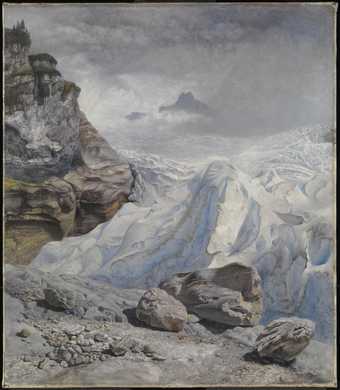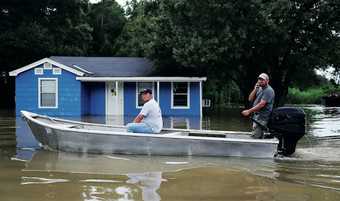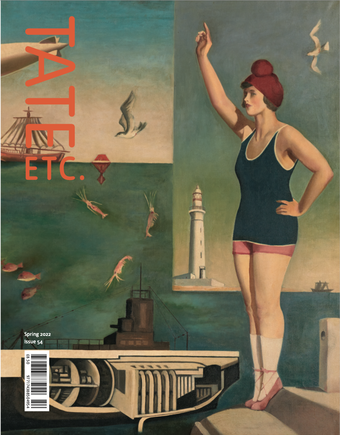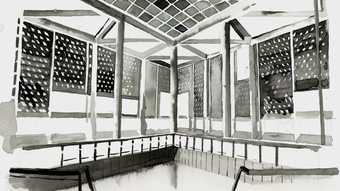
Thao Nguyen Phan Ink drawing for the animation part of First Rain, Brise Soleil 2021. © Thao Nguyen Phan, courtesy of the artist
TATE ETC. What inspired your new work for Tate St Ives?
THAO NGUYEN PHAN Last year, I had the chance to visit the Bangladesh National Parliament House in Dhaka, designed by Louis Kahn and Muzharul Islam. It was a sublimely beautiful, spiritual experience. However, standing in the quiet prayer room, I noticed through the glass windows that birds were trapped inside the courtyard of the tall octagonal structure. They were unable to fly out of the voids between the different parts of the building and kept crashing into the glass until eventually they fell to the ground. This image haunted me, and I started to think about the impact of buildings on the non-human as well as humans. Each year, I discovered, countless tons of sand and gravel are taken from the bed of the Mekong River for construction purposes, such as concrete production. How can we conceive of a kind of architecture that is considerate to humans, the river, animals and other non-human elements?
ETC. How do you hope to explore these ideas?
TNP I have been making a new multi-channel video installation and a series of abstract silk and lacquer paintings, inspired by the practice of pioneering women in modern art such as Diem Phung Thi and Nasreen Mohamedi. The title of the project, First Rain, Brise Soleil, makes reference to Sa mưa – a poetic term in the Vietnamese language for the first rain of the monsoon season, marking the beginning of the agricultural and spiritual cycle of the people who live in the Mekong Delta – and brise soleil, or sun-blocking screens. These were an architectural element widely used in the construction of modernist buildings in the Republic of Vietnam [also called South Vietnam, existing as a country from 1955 to 1975], and in New Khmer architecture during the period of rule by the Sangkum Reastr Niyum (1955–70) in the Kingdom of Cambodia.
I have animated one set of ink drawings as part of the video, while the silk and lacquer paintings reference real and imagined examples of brise soleil from the region of my birth and beyond. The work also includes references from a Vietnamese folk tale which explores the romantic love between a Khmer woman and a Vietnamese man. For me, this tale is a metaphor for the invasion of the Viet ethnic group from the north of Vietnam to my country’s central and southern lands, once called Kampuchea Krom, nowadays known as the Mekong Delta. Through all of these elements, I am looking to create a conceptual space that explores the architectural and political dimensions of folklore, and the progress of modern dwellings and urbanism in my region, to propose an alternative way of understanding water, land, border and territory.

Thao Nguyen Phan Video still from Becoming Alluvium 2019. © Thao Nguyen Phan, courtesy of the artist
ETC. You often return to the Mekong Delta in your work. How have you come to understand this region, which is also likely to be one of the most dramatically affected by climate change?
TNP For me, the Mekong is a place of romance and mythology; it is also a place of destruction, degradation and human greed. There is a local Mekong literature that describes, sometimes stereotypically, the river of rich, abundant resources, where people seem laid back and free in spirit. But the rapid swipe of modernisation has transformed the Delta into a sad, wasted place of excessive agricultural production.
Following a series of socio-economic reforms introduced in 1986, Vietnam rapidly developed from a country that suffered from food scarcity into one of the world’s top exporters of rice. Now this rich land is in the process of disappearing into the ocean as sea levels rise. Countless fruit orchards and paddies have been irreparably damaged by salt-water intrusion, and the rate of disappearance of natural mangrove forests is alarming.
During the shooting of First Rain, Brise Soleil in July 2020, I stayed in a stilt house next to some rice paddies in Dong Thap province in the Mekong Delta. The owner of the field told us that the annual flood, which brings alluvium to nurture the land, no longer comes, since the whole province is now surrounded by a system of dikes. As his house no longer needed to be on stilts, he wished to build a concrete house on the ground. That was his dream. The concrete dream of his is also the dream of many Mekong residents. But his children will probably have to pay off that debt in the endless production chains of the cities.
ETC. Your videos and paintings often contain references to literature, interleaved with Vietnamese folk tales and oral histories. How have you approached storytelling in First Rain, Brise Soleil?
TNP In my previous works I created a balance between traditional stories – Vietnamese folk tales and oral histories – and well-known literary works, such as the writings of Rabindranath Tagore, Marguerite Duras and Italo Calvino in my work Becoming Alluvium 2019, or Yasunari Kawabata in Mute Grain 2019. However, in First Rain, Brise Soleil, I am embarking on a more unknown journey, referencing only the folklore and memory of local people. In Vietnam, the iconic literary works of writers from the West, such as America and Europe, are well translated and studied, but not the literary and folk traditions of Cambodia or Laos, for example. We are neighbours, but we’re so far apart, so this project has been a rediscovery of cultures that are close yet very distant.
First Rain, Brise Soleil was partly inspired by a conversation I had with my uncle about his experiences as a young man during the Cambodian–Vietnamese war in 1979. It was a war that was rarely discussed in the media and is still taboo in Vietnamese official history. Our conversation inspired me to construct the script for my film: the fictional memoir of a construction worker who was present at the destruction of the Preah Suramarit National Theatre in Phnom Penh, a building that was designed by the Cambodian modernist icon Vann Molyvann.

Thao Nguyen Phan Video still from First Rain, Brise-Soleil 2021. © Thao Nguyen Phan, courtesy of the artist
ETC. In the past you have described your work as ‘an investigation into how truth can be understood’. What do you mean by this?
TNP Looking back at the education I received growing up in Vietnam – not knowing anything about the history of my country apart from the narrow, official version that was in the textbook – it has always felt necessary to me to examine the slippery area between truth and fiction. Collapsing the idea of absolute truth, I attempt to weave moving images, paintings and objects into an ambiguous version of truth, a subtle criticism of the grand illusions that have haunted our era: modernity, equality and progress.
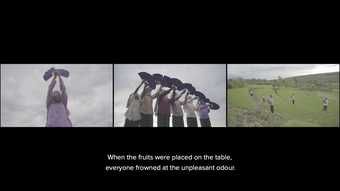
Thao Nguyen Phan Video still from First Rain, Brise-Soleil. © Thao Nguyen Phan, courtesy of the artist
ETC. Do you think modernity is always destructive?
TNP I am intrigued by how we all perceive the idea of modernity very differently. Modernity is a radical and enlightening, but also an extremely violent and unforgiving process.
When I was a student at the Fine Arts University in Saigon, I would go on field trips every year to the remote countryside, where I taught English to local children and transplanted rice with farmers in their paddies. No matter how hard I tried, I could not put the rice in straight. The basic skill that every farmer knows is passed from generation to generation. However, since their skills are so lacking in capitalist value, most famers eventually end up going to the city for employment. In their new situation they are considered uneducated, unskilled, backward. I started to wonder, how did these invaluable skills become so out of fashion in the progress of modernisation?
For me, a gentler kind of modernity would employ empathy not erasure. Like most Vietnamese, I have some naïve, basic belief in the cycle of life as an endless process of reincarnation. In our past lives we could have been a tree, a rock or an animal. There should not be any discrimination between these lives, and if we can maintain some kind of conscious or unconscious memory of being a tree, a rock or an animal, then progress could be radical without being impulsive, enlightening without being aggressive.
Thao Nguyen Phan, Tate St Ives, 5 February – 2 May 2022. Curated by Anne Barlow, Director, Tate St Ives, with Giles Jackson, Assistant Curator. Supported by the Thao Nguyen Phan Exhibition Supporters Circle. The production of First Rain, Brise Soleil is kindly supported by the Han Nefkens Foundation.

